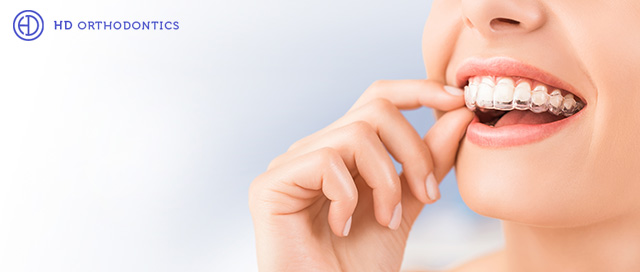Leading Factors to Pick Invisalign Over Other Orthodontic Treatments
Leading Factors to Pick Invisalign Over Other Orthodontic Treatments
Blog Article
Invisalign vs. Conventional Dental braces: Which Option Is Right for You?
When taking into consideration orthodontic therapy, the option between Invisalign and traditional braces presents several important variables that warrant cautious assessment. Invisalign provides a discreet alternative with detachable aligners, while standard braces offer a more visible yet reliable solution for extreme imbalance.
Summary of Therapy Options

In contrast, standard dental braces include steel braces and wires that are adhered to the teeth. This method applies continual pressure gradually to attain alignment. While efficient for complex orthodontic problems, standard dental braces require routine gos to for changes and can pose difficulties in keeping dental health due to the difficulty of cleansing around cables and braces.
Both alternatives have their merits, and the choice typically pivots on details oral conditions, lifestyle preferences, and client compliance. Inevitably, consulting an orthodontic professional is important for figuring out one of the most ideal therapy strategy customized to specific demands. Recognizing the subtleties of each alternative can significantly influence the total success of orthodontic therapy.
Aesthetic Considerations
A significant variable affecting the choice in between Invisalign and standard dental braces is the aesthetic appeal each therapy provides. Invisalign aligners are crafted from clear plastic, making them virtually unseen when used.
On the other hand, conventional dental braces consist of steel braces and wires, which can be a lot more visible. While advancements in orthodontic modern technology have led to the advancement of smaller brackets and tinted elastics, conventional dental braces still maintain a more obvious profile. For some people, the visibility of dental braces might hinder them from looking for essential treatment.
Inevitably, the choice between Invisalign and standard braces might depend upon personal choices concerning aesthetics. People who prioritize discernment often favor Invisalign, while those that are less concerned concerning visibility may go with traditional braces. Recognizing the aesthetic ramifications of each alternative is essential for making a notified choice that aligns with one's lifestyle and preferences.
Comfort and Convenience

In regards to convenience, Invisalign aligners are removable, making it possible for people to appreciate their favorite foods without restriction and keep ideal dental health. Brushing and flossing are simplified, as the aligners can be obtained throughout these routines, whereas traditional dental braces need mindful navigating around braces and cables.
In comparison, standard dental braces necessitate normal adjustments, making them much less practical for those with active schedules. Generally, the comfort and benefit of Invisalign make it an enticing choice for lots of individuals looking for orthodontic therapy.
Treatment Period and Performance
While both Invisalign and conventional dental braces work in remedying dental imbalances, the duration of therapy can differ considerably in between both options. Normally, Invisalign treatment can take anywhere from 12 to 18 months, depending upon the intricacy of the instance. The clear aligners function by gradually shifting teeth right into their desired settings, and routine follow-ups with an orthodontist aid make certain progress remains on the right track.
In contrast, standard dental website link braces usually call for a longer commitment, usually ranging from 18 months to three years. This is due to their set nature and using brackets and wires, which can be more effective for severe misalignments and complex instances (Invisalign). The treatment efficiency of typical braces is well-documented, as they permit for exact modifications and greater control over tooth movement
Inevitably, the option between Invisalign and typical dental braces may pivot on both the awaited treatment period and the certain oral problems at hand. Consulting with an orthodontist is essential, as they can provide customized recommendations based why not check here upon specific requirements, guaranteeing the picked method straightens with wanted end results and timeframes.
Price Contrast and Insurance Coverage Options
Expense plays a substantial role in the decision-making procedure for individuals taking into consideration orthodontic treatment, whether choosing for Invisalign or traditional braces. Generally, the cost of Invisalign arrays from $3,000 to $8,000, while standard dental braces generally cost between $2,000 and $6,000. Elements affecting these prices include the intricacy of the situation, the period of therapy, and geographical area.
Many oral insurance plans supply partial insurance coverage for orthodontic treatments, yet the specifics can vary commonly. Generally, conventional dental braces may be a lot more frequently covered by insurance plans contrasted to Invisalign, which some insurance companies categorize as a cosmetic treatment.
In addition, a number of orthodontic methods supply adaptable repayment plans, making both treatment alternatives extra accessible. Patients should ask about prospective financing choices and discounts for upfront payments. Evaluating the overall price, consisting of insurance benefits and repayment strategies, is necessary for making a notified choice that lines up with both aesthetic preferences and budget factors to consider.

Final Thought
In summary, the selection between Invisalign and conventional dental braces hinges on several elements, including aesthetic choices, comfort, therapy period, and price. Invisalign uses a discreet, removable option that facilitates dental health find more info and nutritional versatility, while conventional braces may be more ideal for complicated dental issues and often come at a reduced rate point. Ultimately, consultation with an orthodontist is vital to analyze specific situations and identify the most proper therapy choice for attaining ideal dental placement.
When considering orthodontic therapy, the choice between Invisalign and traditional braces provides numerous essential aspects that warrant mindful analysis.Comparing Invisalign and standard braces discloses unique treatment alternatives for orthodontic improvement.While both Invisalign and traditional braces are reliable in fixing oral imbalances, the duration of treatment can differ dramatically between the two alternatives.Price plays a significant duty in the decision-making procedure for individuals considering orthodontic therapy, whether deciding for Invisalign or conventional braces.In recap, the option between Invisalign and standard braces hinges on numerous variables, including aesthetic preferences, convenience, therapy period, and cost.
Report this page